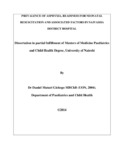| dc.contributor.author | Gichogo, Daniel M | |
| dc.date.accessioned | 2014-11-27T06:56:45Z | |
| dc.date.available | 2014-11-27T06:56:45Z | |
| dc.date.issued | 2014 | |
| dc.identifier.uri | http://hdl.handle.net/11295/75439 | |
| dc.description | Masters | en_US |
| dc.description.abstract | Background
Birth asphyxia accounts for up to a third of neonatal mortality worldwide. Appropriate newborn
resuscitation can reduce these mortalities. This study was carried out to determine the prevalence
of asphyxia and maternal factors associated with it in Naivasha District hospital and attitudes and
practices of health workers who perform resuscitation of the neonates with asphyxia
Objectives
The primary objective was to determine the prevalence of birth asphyxia and associated risk
factors at Naivasha District Hospital. The secondary objectives were to describe readiness for
neonatal resuscitation and also the attitudes and practices of health workers providing
resuscitation to the asphyxiated neonates in Naivasha District Hospital.
Methods
A longitudinal cross sectional study was done in the Maternity unit of Naivasha District Hospital
from August 2012 to October 2012. Two hundred and thirty seven babies were consecutively
enrolled in the study. Twenty eight health workers were also recruited into the study. Prevalence
of asphyxia and assessment of health worker practices and attitudes was obtained by observation
of consecutive deliveries and assessing for asphyxia. Identification of the risk factors was done
by interviewing the mothers and reviewing their medical records. The necessary information
was collected from maternal clinical records and pre-designed questionnaire.
of birth asphyxia were duration of labour OR=3.86[95% CI, p=0.041] , meconium staining of
amniotic fluid and presence of oedema in pre/eclampsia. All basic resuscitation equipment was
found to be available in labour ward and newborn unit. At every delivery the delivery team was
always ready for resuscitation. There was good resuscitation practice with only one of 13 areas
of evaluation being inappropriate where 10mls of saline was administered via the umbilical vein
which was administered to 4 (25%) of the asphyxiated babies. | en_US |
| dc.language.iso | en | en_US |
| dc.publisher | University of Nairobi | en_US |
| dc.title | Prevalence of asphyxia, readiness for neonatal resuscitation and associated factors in Naivasha district hospital | en_US |
| dc.type | Thesis | en_US |
| dc.description.department | a
Department of Psychiatry, University of Nairobi, ; bDepartment of Mental Health, School of Medicine,
Moi University, Eldoret, Kenya | |
| dc.type.material | en_US | en_US |

